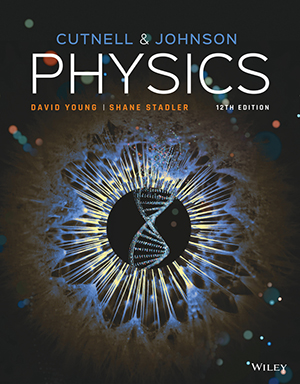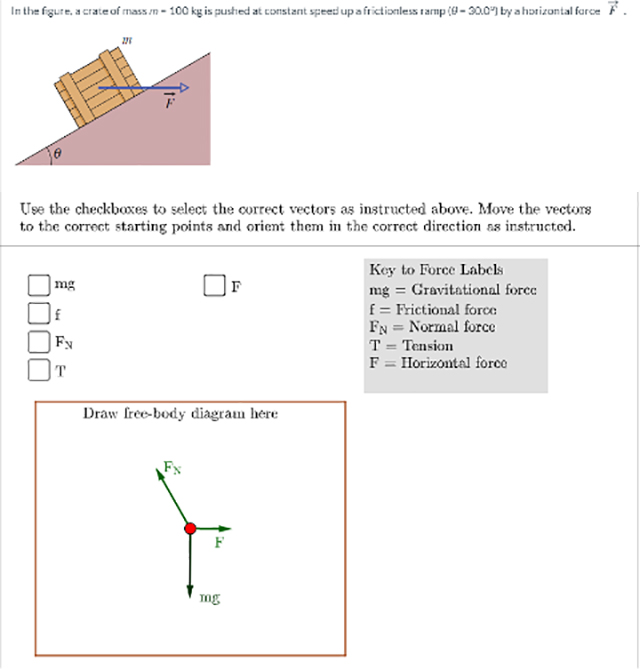
Physics, 12th Edition
By John D. Cutnell, Kenneth W. Johnson, David Young, and Shane Stadler
Physics 12th Edition gives students the skills necessary to building conceptual understanding, problem solving, and real-world discovery.
WileyPLUS will continue to give instructors increased flexibility to tailor a variety of assignments and practice activities to their students. Activities are designed to keep students on track, and confident.
A wide array of tools will help students stay engaged in active learning: animated pre-lecture videos (created and narrated by the authors) explain the basic concepts and learning objectives of each section – problem solving strategies are discussed, and common misconceptions and potential pitfalls are addressed; chalkboard videos demonstrate step-by-step practical solutions to typical homework problems; tutorials implement a step-by-step approach to problem solving skills.
Schedule a Demo Request Instructor AccountWant to learn more about WileyPLUS? Click Here
259 Pre-Lecture Video Animations
259 total lecture videos narrated by the authors for every section. They introduce the basic concepts and learning objectives for each section. Each video is accompanied by assignable questions in WileyPLUS. These are designed to check students understanding and provide an additional learning medium while accommodating additional learning strategies. This is well suited for “flipping the classroom,” although it also serves for conventional lecturing. Videos are available for students for review at any time.

Vector Drawing Questions
For many problems involving multiple forces, an interactive free body diagram drawing tool through GeoGebra is available to construct the diagrams. This is a critical first step for students solving many equilibrium and non-equilibrium problems with Newton’s Second Law.
Adaptive Assignments powered by Knewton
Adaptive Assignments powered by Knewton for every chapter ignite students’ confidence to persist so that they can succeed in their courses and beyond. By continuously adapting to each students’ needs and providing achievable goals with just-in-time instruction directly from the 12th edition, Adaptive Assignments close knowledge gaps to accelerate learning in WileyPLUS.
Features Include
-
- GO Tutorials lead the student through key ideas and hints when wrong answers are submitted. The final answer is not given and left up to the student to solve though.
- Chalkboard Short Videos: 170+ videos guide a student step-by-step through a practical solution for problems presented in the course.
- Group/Team Problems: New group problems have been added to each chapter and are useful for in-class group activities.
- Biological Application Examples: “The Physics of …” are bio-inspired examples like what pre-med students will encounter in the Chemical and Physical Foundations of Biological Systems passages section of the MCAT.
- Math Help Videos
- Physics Demonstration Videos with Assessment Questions
- Physics Concepts Simulations
- Problem-Solving Help Videos
Instructor Resources
- New TestGen computerized test bank allows for quick creation of quizzes or tests. TestGen provides a variety of question types and also allows instructors to create their own questions.

David Young received his Ph.D. in experimental condensed matter physics from Florida State University in 1998. He then held a post-doc position in the Department of Chemistry and the Princeton Materials Institute at Princeton University before joining the faculty in the Department of Physics and Astronomy at Louisiana State University in 2000. His research focusses on the synthesis and characterization of high-quality single crystals of novel electronic and magnetic materials. The goal of his research group is to understand the physics of electrons in materials under extreme conditions, I.e., at temperatures close to absolute zero, in high magnetic fields, and under high pressure. His is the coauthor of more than 250 research publications that have appeared in peer-reviewed journals, such as Physical Review B, Physical Review Letters, and Nature. Professor Young has taught introductory physics with the Cutnell & Johnson text since he was a senior undergraduate almost 30 years ago. He routinely lectures to large sections, often more than 300 students. To engage such a large number of students, he uses WileyPLUS, electronic response systems, tutorial-style recitation sessions, and in-class demonstrations. Professor Young has received multiple awards for outstanding teaching of ungraduated. David enjoys spending his free time with his family, playing basketball, and working on his house.
I would like to thank my family for the continuous love and support. – David Young

Shane Stadler earned a Ph.D. in experimental condensed matter physics from Tulane University in 1998. Afterwards, he accepted a National Research Council Postdoctoral Fellowship with the Naval Research Laboratory in Washington, DC, where he conducted research on artificially structured magnetic materials. Three years later, he joined the faculty in the Department of Physics at Southern Illinois University (the home institution of John Cutnell and Ken Johnson, the original authors of the textbook), before joining the Department of Physics and Astronomy at Louisiana State University in 2008.
Over the past 20 years, Professor Stadler has taught the full spectrum of physics courses, from physics for students outside the sciences to graduate-level physics courses, such as classical electrodynamics. He teaches classes that range from fewer than ten students to those with enrollments me than 300. His educational interests are focused on developing teaching tools and methods that apply to both small and large classes, and which are applicable to emerging teaching strategies, such as “flipping the classroom.” In his spare time, Shane writes science fiction/thriller novels.
I would like to thank my parents, George, and Elissa, for their constant support and encouragement. – Shane Stadler.
- Introduction and Mathematical Concepts
- Kinematics in One Dimension
- Kinematics in Two Dimensions
- Forces and Newton’s Laws of Motion
- Dynamics of Uniform Circular Motion
- Work and Energy
- Impulse and Momentum
- Rotational Kinematics
- Rotational Dynamics
- Simple Harmonic Motion and Elasticity
- 1 Fluids
- Temperature and Heat
- The Transfer of Heat
- 1 The Ideal Gas Law and Kinetic Theory
- Thermodynamics
- Waves and Sound
- The Principle of Linear Superposition and Interference Phenomena
- Electric Forces and Electric Fields
- Electric Potential Energy and the Electric Potential
- Electric Circuits
- Magnetic Forces and Magnetic Fields
- Electromagnetic Induction
- Alternating Current Circuits
- Electromagnetic Waves
- The Reflection of Light: Mirrors
- The Refraction of Light: Lenses and Optical Instruments
- Interference and the Wave Nature of Light
- Special Relativity
- Particles and Waves
- The Nature of the Atom
- Nuclear Physics and Radioactivity
- Ionizing Radiation, Nuclear Energy, and Elementary Particles

